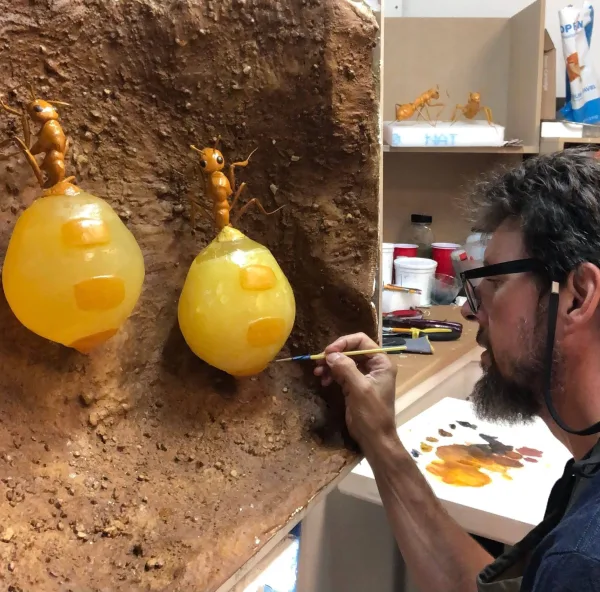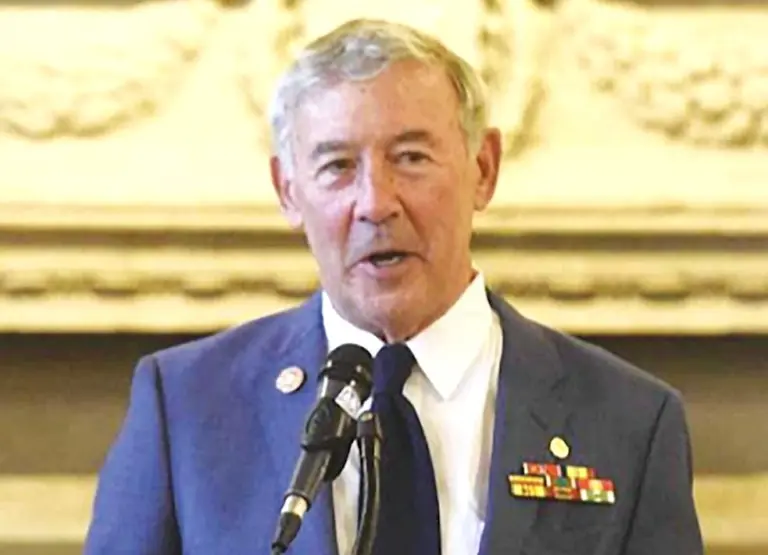
By Anne W. Semmes
Enter technology – a 3D printer and CT scanner able to produce a digital model of an ant, to expand or contract as needed, “so you can see every hair, every spine, every segment,” informs Dr. Daniel Ksepka, Curator of Science at the Bruce Museum. Hence, an exhibit able to display 50 plus large models of ants with the world’s largest, the Giant Amazonian Ant (Dinoponera) measuring five and a half feet – 35 times its 1.6 inches life-size. With its name of “Buckley,” to sit next to the smallest Carberra ant, 35 times its quarter of an inch life-size.
Welcome to the “Ant: Tiny Creatures, Big Lives” exhibit at the Bruce Museum opening Friday, November 14!
This artfully crafted and intriguing exhibit introduces bigtime the mostly hidden and mysterious world of one of the earth’s smallest but ever-present creatures, the ant. The exhibit grew from the childhood fascination of Ksepka. “I love ants,” he confirms, and yes, from the age of four. He now knows there are an estimated 20,000 ant species with only some 12,000 “formally studied or identified as new.” Plenty left “for kids to discover,” he tells, like his six-year-old daughter Phoebe. “She loves ants.”
Logical, that Ksepka would dream of presenting an exhibit on ants. But no live ants are to be present. “We decided no leaf cutter ant colonies,” tells Ksepka. “You’ve seen our beautiful Richter Gallery with its Pissarro’s, Matisse and Renoir. We wouldn’t want to see the ants coming back and forth carrying little pieces of those paintings… We do have a lot of great photos and videos to show how they behave in life.”
“Ants are small,” says Ksepka, “with a tray of specimens you can barely see those hairs and spines and stingers. Why not make the ants bigger?” Happily, on the Museum staff was a wizard able to create all sorts of objects for display, Sean Murtha, exhibition preparer.
Murtha has worked in museums for 30 years, 19 of those years at the Bruce. This ant exhibit reminds him of exhibits he prepared at the American Museum of Natural History in New York. He’s trained as a 2D painter, but he’s largely a sculptor of three-dimensional objects, in smaller scale to that five-foot-plus “Buckley,” crafted by retired staffer Dan Buckley returning for a little freelance sculpting.
Besides Buckley, Murtha notes, “most of the ant models are about four to eight inches long. Some are in little habitats, little dioramas,” but the ‘real thing’ we have in the show are those ant nests.”
Ant nest sculptures
Ksepka describes how “really cool” those casts of ant nests are created by Floridian Walter R. Tschinkel, a myrmecologist, entomologist, and Pulitzer Prize winner for his book, “The Fire Ants.” “He takes aluminum and melts it into liquid and pours it down the ant [nest] hole, and it spreads quickly out to all the passages, and then it cools and becomes solid metal. And then he digs it up. And it looks like a sculpture… like abstract art. It’s just so beautiful.”
“Before this,” Ksepka continues, “it was really hard to tell what the ants were up to under there…And this lets us know so much more about how deep they go, how they branch, what’s the angle, where does the queen sit, where do the eggs go? And so, we’re having nine of Tschinkel’s nests in the show, and I love them.”
Entering the ant exhibit
Wondrously is how Murtha has transformed the third floor Science Gallery with his entryway for the “Tiny Creatures, Big Lives” exhibit. “You’ll go through a tunnel that starts out like a hallway, but as you go through, it becomes rounded and the walls become sandy.” And passing through, you’ll come upon a little side tunnel, seeing in the darkness a large ant to clue you in you are basically shrinking and the ant world is growing.” Entering into the exhibit, “you’ll see Buckley the big ant straight ahead of you.”
That exhibit room is “a warm brown color, chocolatey,” with no ant sounds. “There’ll be a video playing a sideshow, but there won’t be any sound.” But there will be smells. He expounds, “Ants do secrete certain odors. So, we’ve got a little display where you get to sample five different ant scents… it’s fun.”
State of the ant world
Back to Ksepka to learn the state of ants in the world. “There are an estimated 2.5 million ants per person. So, there’s lots of them,” with “the odorous house ant more than happy to move into our homes. The pavement ants love the pavement. Other ants are in trouble, because we brought new ant species into their habitat.” Such as the red fire ant. “It comes from South America. We somehow let it loose. And now it’s in a lot of the southern United States… It can build big mounds that damage farm equipment. It goes into electrical boxes, transformers and chews on the wires. So, it can cause power outages. And of course it stings people… So, there are a lot of invasive ant species.”
And surprisingly across their 150 million years, “Females are in total control,” tells Ksepka, with this ant exhibit displaying only one male ant. “So, the queen is obviously female, but when you see the workers, they’re female. When you see the soldiers, those are female. When you see the honeypot ant that holds the liquid in its abdomen, that’s female. So, the males hatch. They loaf about…and when it comes time, they fly away and try to mate, and then they die…often in hours or days. And so, their only purpose in life is to mate one time.”
And note, there is also only one place on earth where there are no ants – Antarctica, though it does have ants in its name Ksepka likes to tell. “There are ants on every other continent. They’re pretty sparse in a desert environment or an urban environment. The real center of diversity for these ants is tropical forests…you’ll see swarms of a million army ants. They’re underground, they’re in the leaf litter, and they’re even in the trees. There are ants that nest in trees…they make their homes out of leaves they weave together into little houses. They join legs and form basically a hammock, and the queen is in the middle…”
Yes, most definitely, Dr. Daniel Ksepka is in love with ants.






